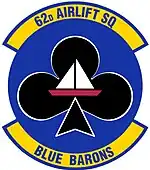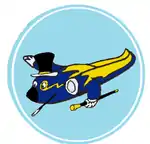62nd Airlift Squadron
 | |
|---|---|
 A 314th Airlift Wing C-130 Hercules delivers relief supplies to Wajir Airport, Kenya | |
| Active | 1942–1946; 1949–present |
| Country | |
| Branch | |
| Role | Airlift Training |
| Part of | Air Education and Training Command |
| Garrison/HQ | Little Rock Air Force Base |
| Nickname(s) | Blue Barons |
| Motto(s) | Primus in Toto Latin First in Everything (WW II, 1993–present) |
| Engagements | Mediterranean Theater of Operations European Theater of Operations Korean War Vietnam War[1] |
| Decorations | Distinguished Unit Citation Air Force Outstanding Unit Award Republic of Korea Presidential Unit Citation[1] |
| Insignia | |
| 62nd Airlift Squadron emblem (approved 9 December 1994)[1] |  |
| 62nd Troop Carrier Squadron emblem (approved 26 October 1993)[1] | .png.webp) |
| 62nd Troop Carrier Squadron emblem (approved 24 April 1953)[2] |  |
| 62nd Troop Carrier Squadron emblem (World War II)[3] | .png.webp) |
The 62nd Airlift Squadron is part of the 314th Airlift Wing at Little Rock Air Force Base, Arkansas. Originally constituted in 1942 as the 62nd Troop Carrier Squadron, it first deployed to Morocco in 1943, remaining in Europe until its inactivation in 1946. It reactivated three years later and deployed to Japan during the Korean War. In 1967, the unit was redesignated the 62nd Tactical Airlift Squadron, and in 1991 the 62nd Airlift Squadron. It operates Lockheed C-130J Super Hercules aircraft and provides advanced training to pilots, copilots, and loadmasters for combat airlift and airdrop operations.
History
World War II
Activated in late 1942 under I Troop Carrier Command and equipped with Douglas C-47 Skytrains. Trained in various parts of the eastern United States. Deployed to French Morocco in May 1943 and assigned to Twelfth Air Force to support combat operations in the North African Campaign. Remained with Twelfth Air Force, moving to Tunisia and Sicily providing transport and resupply operations as well as casualty evacuation of wounded personnel in the Mediterranean Theater of Operations (MTO). Reassigned to IX Troop Carrier Command in England during early 1944 as part of the build-up of Allied forces prior to the D-Day invasion of France.
Began operations by dropping paratroops into Normandy on D-Day (6 June 1944) and releasing gliders with reinforcements on the following day. The unit received a Distinguished Unit Citation and a French citation for these missions.
After the Normandy invasion the squadron ferried supplies in the United Kingdom. The squadron also hauled food, clothing, medicine, gasoline, ordnance equipment, and other supplies to the front lines and evacuated patients to rear zone hospitals. It dropped paratroops near Nijmegen and towed gliders carrying reinforcements during the airborne attack on the Netherlands. In December, it participated in the Battle of the Bulge by releasing gliders with supplies for the 101st Airborne Division near Bastogne.
Moved to Belgium in early 1945, and participated in the Western Allied invasion of Germany, participating in the air assault across the Rhine River in March 1945, each aircraft towed two gliders with troops of the 17th Airborne Division and released them near Wesel.
Post-war
After V-E Day, became part of the United States Air Forces in Europe, at Villacoublay Airfield and was part of the European Air Transport System, supporting the occupation forces in Germany as well as carrying supplies and personnel between various stations in Western Europe. Inactivated in early 1946 while stationed in France.
Tactical Air Command
Reactivated as part of Tactical Air Command (TAC) in 1949 with Fairchild C-82 Packets and various gliders as an assault squadron.
Korean War
Deployed to Japan for combat operations in 1950 for the Korean War. Furnished airlift between Japan and Korea and airdropped paratroops and supplies at Sukchon/Sunchon and Munsan-ni. was part of airborne assaults on Sukchon and Munsan-ni.
Return to United States
Returned to the United States in 1954, was equipped by TAC as one of the first Lockheed C-130 Hercules squadrons when the aircraft came into operational service. The squadron flew airlift from the Philippines into Vietnam, March–May 1965.
Flying training
It has conducted C-130 Training since 1971.
2020 Coronoavirus epidemic
To protect Air Force personnel from infection, in 2020 the squadron took on a new task: flying Air Education and Training Command students to training locations. Normally such students take commercial flights.[4]
Campaigns and decorations
- Campaigns. World War II: Sicily; Naples-Foggia; Rome-Arno; Normandy; Northern France; Rhineland; Central Europe. Korea: UN Defensive; UN Offensive; CCF Intervention; First UN Counteroffensive; CCF Spring Offensive; UN Summer-Fall Offensive; Second Korean Winter; Korea Summer-Fall, 1952; Third Korean Winter; Korea, Summer 1953. Vietnam: Vietnam Defensive.
- Decorations. Distinguished Unit Citations: Sicily, 11 July 1943; France, [6–7] Jun 1944; Korea, 28 November-10 Dec 1950. Air Force Outstanding Unit Awards: 6 May 1953 – 10 September 1954; 11 January-14 Feb 1955; 1 January 1960 – 31 December 1961; 1 September 1962 – 15 April 1963; 1 December 1965 – 30 June 1967; 1 June 1969 – 31 May 1971; 1 January 1975 – 30 June 1976; 1 June 1985 – 31 May 1986; 1 July 1991 – 30 June 1993; 1 July 1993 – 30 June 1995; 1 July 1995 – 31 March 1997; 1 July 1997 – 30 June 1999; 1 July 1999 – 30 June 2001; 1 July 2001 – 30 June 2003; 1 July 2003 – 30 June 2004; 1 July 2005 – 30 June 2006; 1 July 2006 – 30 June 2007; 1 July 2008 – 30 June 2009. Republic of Korea Presidential Unit Citation, 1 July 1951 – 27 July 1953.
Lineage
- Constituted as the 62d Troop Carrier Squadron on 27 November 1942
- Activated on 5 December 1942
- Inactivated on 27 August 1946
- Redesignated 62d Troop Carrier Squadron, Medium on 20 September 1949
- Activated on 17 October 1949
- Redesignated 62d Troop Carrier Squadron on 1 March 1966
- Redesignated 62d Tactical Airlift Squadron on 1 May 1967
- Redesignated 62d Airlift Squadron on 1 December 1991[1]
Assignments
- 315th Troop Carrier Group, 5 December 1942 (attached to 89th Troop Carrier Group)
- 314th Troop Carrier Group, 15 March 1943
- Third Air Force, Aug-27 August 1946
- 314th Troop Carrier Group, 17 October 1949
- 314th Troop Carrier Wing, 8 October 1957 (attached to 322d Air Division 6 June–August 1961, Detachment 3, 315th Air Division, 19 May-29 July 1962 and 5 August–October 1964, 315th Air Division, March–May 1965)
- 839th Air Division, 1 December 1965 (attached to Troop Carrier Wing Provisional, 4413)
- 64th Troop Carrier Wing (later 64th Tactical Airlift Wing), 1 July 1966 (attached to 513th Tactical Airlift Wing, 15 December 1967 – 8 April 1968, 29 June-2 Oct 1968, 16 November 1969 – 11 January 1970, 3 July-30 August 1970; 322d Tactical Airlift Wing, 10 April-12 Jun 1971)
- 314th Tactical Airlift Wing, 31 May 1971
- 34th Tactical Airlift Training Group, 1 November 1978
- 314th Operations Group, 1 December 1991 – present[1]
Stations
|
|
Coronoavirus EpidemicCoronoavirus Epidemic
Aircraft
- Douglas C-47 Skytrain (1943–1946)
- Fairchild C-82 Packet (1949–1950)
- Fairchild C-119 Flying Boxcar (1950–1957)
- Lockheed C-130 Hercules (1956 – present)[1]
References
Notes
- 1 2 3 4 5 6 7 Robertson, Patsy (15 December 2010). "Factsheet 62 Airlift Squadron". Air Force Historical Research Agency. Retrieved 5 October 2017.
- ↑ Maurer, Combat Squadrons, pp. 240–241
- ↑ Watkins, p. 69
- ↑ Ford, Jaden. "Little Rock AFB's 62nd AS protects training pipeline with airlift assistance". Air Education and Training Command. U.S. Air Force. Retrieved 25 March 2021.
- ↑ Station number in Anderson.
- 1 2 Station number in Johnson.
- ↑ Station information in Robertson, except as noted.
Bibliography
![]() This article incorporates public domain material from the Air Force Historical Research Agency
This article incorporates public domain material from the Air Force Historical Research Agency
- Anderson, Capt. Barry (1985). Army Air Forces Stations: A Guide to the Stations Where U.S. Army Air Forces Personnel Served in the United Kingdom During World War II (PDF). Maxwell AFB, AL yes: Research Division, USAF Historical Research Center. Archived from the original (PDF) on 23 January 2016. Retrieved 28 June 2017.
- Johnson, 1st Lt. David C. (1988). U.S. Army Air Forces Continental Airfields (ETO) D-Day to V-E Day (PDF). Maxwell AFB, AL: Research Division, USAF Historical Research Center. Archived from the original (PDF) on 29 September 2015. Retrieved 26 June 2017.
{{cite book}}: CS1 maint: numeric names: authors list (link) - Maurer, Maurer, ed. (1983) [1961]. Air Force Combat Units of World War II (PDF) (reprint ed.). Washington, DC: Office of Air Force History. ISBN 0-912799-02-1. LCCN 61060979. Retrieved 17 December 2016.
- Maurer, Maurer, ed. (1982) [1969]. Combat Squadrons of the Air Force, World War II (PDF) (reprint ed.). Washington, DC: Office of Air Force History. ISBN 0-405-12194-6. LCCN 70605402. OCLC 72556. Retrieved 17 December 2016.
- Ravenstein, Charles A. (1984). Air Force Combat Wings, Lineage & Honors Histories 1947-1977. Washington, DC: Office of Air Force History. ISBN 0-912799-12-9. Retrieved 17 December 2016.
- Watkins, Robert (2008). Battle Colors. Vol. III Insignia and Markings of the Ninth Air Force in World War II. Atglen, PA: Shiffer Publishing Ltd. ISBN 978-0-7643-2938-8.
Volume IV, European-African-Middle Eastern Theater of Operations

.svg.png.webp)